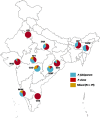Malaria diagnosis by PCR revealed differential distribution of mono and mixed species infections by Plasmodium falciparum and P. vivax in India
- PMID: 29565981
- PMCID: PMC5863947
- DOI: 10.1371/journal.pone.0193046
Malaria diagnosis by PCR revealed differential distribution of mono and mixed species infections by Plasmodium falciparum and P. vivax in India
Abstract
Malaria is a vector-borne infectious disease, caused by five different species of the genus Plasmodium, and is endemic to many tropical and sub-tropical countries of the globe. At present, malaria diagnosis at the primary health care level in India is conducted by either microscopy or rapid diagnostic test (RDT). In recent years, molecular diagnosis (by PCR assay), has emerged as the most sensitive method for malaria diagnosis. India is highly endemic to malaria and shoulders the burden of two major malaria parasites, Plasmodium falciparum and P. vivax. Previous studies using PCR diagnostic assay had unraveled several interesting facts on distribution of malaria parasites in India. However, these studies had several limitations from small sample size to limited geographical areas of sampling. In order to mitigate these limitations, we have collected finger-prick blood samples from 2,333 malaria symptomatic individuals in nine states from 11 geographic locations, covering almost the entire malaria endemic regions of India and performed all the three diagnostic tests (microscopy, RDT and PCR assay) and also have conducted comparative assessment on the performance of the three diagnostic tests. Since PCR assay turned out to be highly sensitive (827 malaria positive cases) among the three types of tests, we have utilized data from PCR diagnostic assay for analyses and inferences. The results indicate varied distributional prevalence of P. vivax and P. falciparum according to locations in India, and also the mixed species infection due to these two species. The proportion of P. falciparum to P. vivax was found to be 49:51, and percentage of mixed species infections due to these two parasites was found to be 13% of total infections. Considering India is set for malaria elimination by 2030, the present malaria epidemiological information is of high importance.
Conflict of interest statement
Figures



References
-
- World Health Organization Malaria factsheet 2016. http://www.who.int/mediacentre/factsheets/fs094/en/ 12/12/2016
-
- World Health Organisation (WHO) World Malaria Report. 2017. http://www.who.int/malaria/publications/world-malaria-report-2017/en/
-
- Das A. The distinctive features of Indian malaria parasites. Trends Parasitol. 2015; 31: 83–86. doi: 10.1016/j.pt.2015.01.006 - DOI - PubMed
MeSH terms
LinkOut - more resources
Full Text Sources
Other Literature Sources

